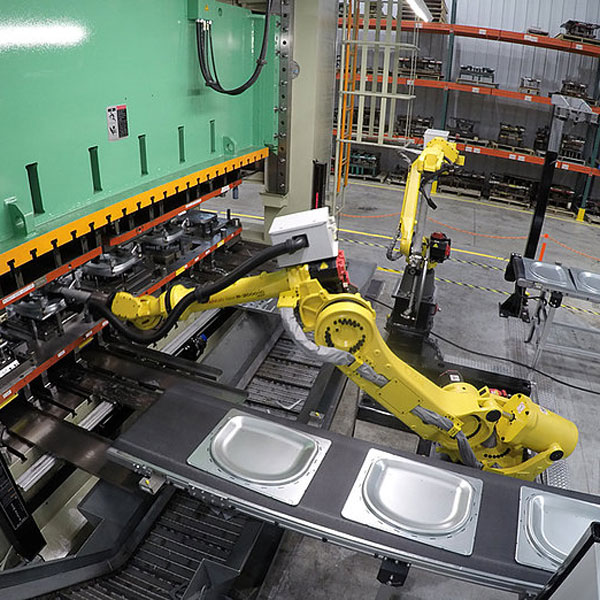Ultimate Guide to Metal Stamping Techniques and Applications
Ultimate Guide to Metal Stamping Techniques and Applications
Blog Article
Steel Stamping Developments: Elevating Production Processes for Superior Results
In the world of making processes, metal stamping has actually long been a foundation strategy for generating a selection of accuracy elements. With the ruthless march of technical innovation, the landscape of steel stamping is going through a substantial makeover.
Evolution of Metal Marking Strategies

Additionally, advancements in product scientific research have resulted in the advancement of high-strength alloys that can now be perfectly marked right into complex forms, satisfying a broader series of commercial applications. The assimilation of robotics and expert system has even more enhanced the marking procedure by boosting rate and accuracy while decreasing the danger of human mistake.

Impact of Advanced Materials
Have sophisticated materials transformed metal stamping processes considerably in the manufacturing industry? The answer is a definite yes (Metal Stamping). The combination of advanced materials has actually changed metal stamping, making it possible for manufacturers to achieve higher precision, enhanced effectiveness, and improved product high quality. By making use of products such as high-strength alloys, advanced composites, and cutting-edge finishes, metal stamping procedures can currently create parts that are lighter, stronger, and more sturdy than ever.
These advanced materials supply premium mechanical homes, corrosion resistance, and thermal stability, allowing makers to fulfill the needs of modern-day industries such as aerospace, automotive, and electronics. Furthermore, the usage of sophisticated products in steel marking has actually promoted the manufacturing of complex geometries and intricate designs that were previously unattainable through conventional techniques.
Moreover, the application of innovative materials has resulted in minimized product waste, reduced manufacturing prices, and much shorter lead times, making metal stamping processes a lot more cost-effective and lasting. As modern technology remains to advance, the influence of innovative products on steel stamping procedures is anticipated to drive further advancement and boost the competition of suppliers in the worldwide market.
Automation in Steel Stamping
The evolution of metal marking processes driven by the assimilation of innovative products has set the phase for considerable advancements in automation within the manufacturing market. Automation in steel stamping has actually revolutionized production procedures, boosting efficiency, precision, and general outcome high quality. Through the application of robotics, sensors, and computer-controlled systems, tasks that were lengthy and once hand-operated can now be executed with exceptional speed and precision.
Automation in metal stamping not just speeds up production prices but also makes sure uniformity in the production process. By lessening human treatment, the danger of mistakes is considerably lowered, resulting in greater levels of item uniformity and dependability. Additionally, automation makes it possible for makers to carry out intricate stamping jobs that would be impractical or tough to attain manually.
Furthermore, automation in steel stamping adds to a much safer working atmosphere by decreasing the requirement for employees to involve in unsafe or repetitive jobs - Metal Stamping. This shift in the direction of automation not just improves performance but also leads the way for the future of production, where modern technology plays a central duty in driving operational quality
Quality Assurance and Evaluation Equipments
With a focus on precision and integrity, quality control and inspection systems play an essential function in guaranteeing item quality in metal marking procedures. These systems are developed to monitor every phase of manufacturing, from material evaluation to the end product, to ensure that all parts fulfill the required requirements. By carrying out advanced innovations such as optical examination systems, coordinate measuring devices (CMM), and automated assessing devices, manufacturers can detect even the tiniest inconsistencies in measurements, surface area high quality, and general integrity of stamped parts.

Sustainability Practices in Metal Stamping
Structure upon the foundation of precision and dependability developed with quality assurance and assessment systems, the integration of lasting practices in steel marking processes is increasingly ending up being a centerpiece for producers looking for to decrease her explanation ecological impact and maximize source use. Sustainability methods in metal stamping encompass a series of initiatives aimed at reducing waste generation, power intake, and greenhouse gas exhausts throughout the production process.
One key aspect of sustainability in steel stamping is the adoption of environmentally friendly materials and modern technologies that promote recyclability and waste reduction. By utilizing recycled materials and implementing energy-efficient equipment, makers can reduce their carbon impact and add to an extra lasting look at this site manufacturing cycle. In addition, optimizing manufacturing procedures to reduce material waste and power usage not just benefits the setting yet additionally results in set you back savings for organizations in the long run.
Furthermore, the application of lasting practices in steel stamping can improve brand name credibility and attract environmentally mindful customers. As sustainability remains to get importance in the manufacturing sector, integrating green initiatives into steel marking processes is necessary for lasting success and competitiveness in the marketplace.
Final Thought
In verdict, metal marking strategies have considerably advanced in time, integrating innovative materials and automation to improve producing procedures. Quality assurance and evaluation systems play a vital duty in ensuring exceptional results, while sustainability techniques are significantly being implemented to reduce environmental effect. These advancements in steel marking have actually changed the sector, bring about more sustainable and efficient production techniques for various industries.
Metal stamping, once a manual and labor-intensive procedure, has actually changed right into an extremely automated and advanced technique of shaping metal sheets into various forms and layouts.Have innovative products changed metal stamping procedures considerably in the production market? By my link making use of products such as high-strength alloys, advanced composites, and cutting-edge finishings, metal stamping procedures can currently create components that are lighter, stronger, and extra long lasting than ever previously.
The development of metal marking processes driven by the integration of innovative products has set the phase for substantial improvements in automation within the manufacturing industry.In verdict, metal stamping strategies have significantly evolved over time, including sophisticated materials and automation to boost making processes.
Report this page